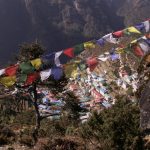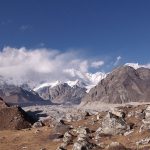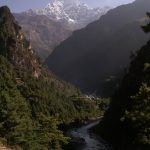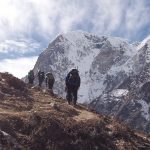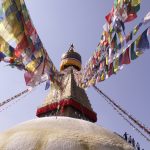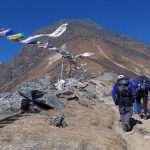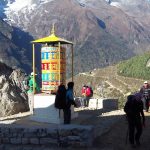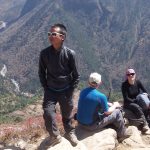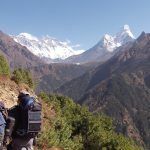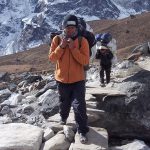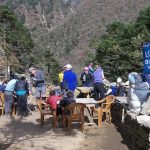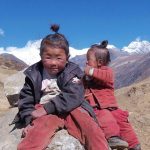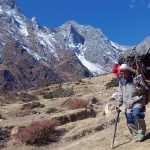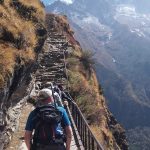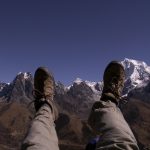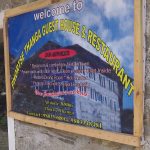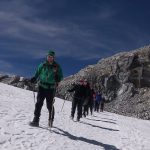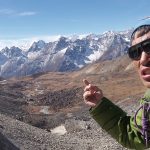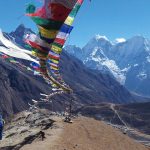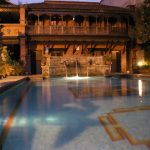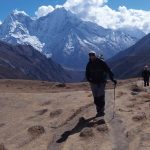Himalayan Jewel Indulge in the best of Nepal
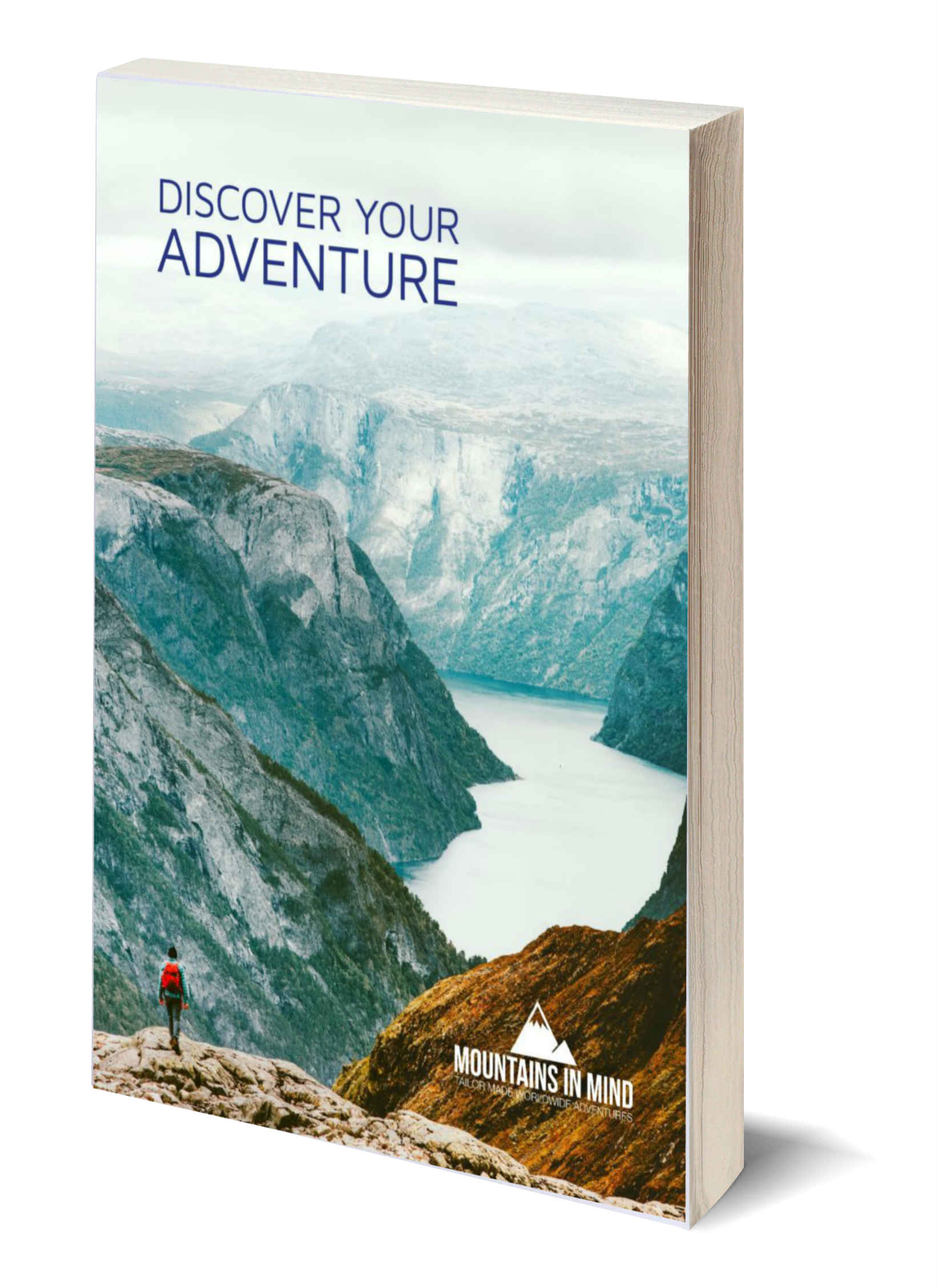

Why Choose Mountains in Mind?
- Excellent Sherpa conditions
- Supports the local community
- Small group sizes
- UK Guide
- Tailored itinerary
- Selective group dates
- Personal touch
- All inclusive price
- Deluxe accommodation
- Optional excursions
- GPS Trackers
-
Our Himalayan Jewel trip presents the best of the Himalayas in our wonderfully tailored package. The essence of the trip is for you to indulge in two bijou treks that capture the beauty and magnificence of Nepal in two weeks, ideal if time is precious. The trekking is more relaxed in nature as it doesn’t reach the same altitude or distance as the more classic treks but is nonetheless stunning and is an equally rewarding experience.
Our trip takes you to both the vibrant city of Kathmandu and the relaxing scenic lakeside city of Pokhara. The jewel in the crown will be trekking to view the majestic Mount Everest, or by its Tibetan name Chomolungma, meaning goddess, mother of the earth. This will be followed in the second week with a short trek in the foothills of the Annapurna range of mountains in the west where you’ll trek to view the dramatic and sacred Machhapuchhre or Fishtail Peak along with the stunning Annapurna Massif.
You’ll be charmed by the dramatic beauty of the mountains and with the warm friendly hospitality that you’ll be greeted with in Nepal. A awe-inspiring experience never to be forgotten.
-
- Saturday 10th October to Monday 27th October 2020
- £3245
- Other dates available. Contact us for details.
-
- International flights
- Internal flights to/from Lukla
- Internal flights to/from Pokhara
- A welcome meal in Kathmandu
- All meals during the trek
- Deluxe accommodation in Kathmandu and Pokhara
- Traditional guest house accommodation on the trek
- A boat trip on Lake Phewa at Pokhara
- A fully supported Sherpa team with Nepali Sirdar
- Porters to carry your overnight baggage
- Full briefing on arrival
- Satellite phone
- Medical support
- Transfers to/from Kathmandu airport
- UK Expedition Leader
- All national park fees
- Online support and advice with your preparation
- Training plan to make the most of your trek (if required)
- Option to attend training weekend in the UK (at additional cost)
- Virtual get-together with question and answer session
- Plus dreams and friends to last a lifetime !!!
-
- Personal Insurance
- IMPORTANT. Confirm with your insurance provider that your policy covers you for trekking at altitude and includes emergency helicopter evacuation to Kathmandu.
- Visa (obtainable at Kathmandu airport)
- Lunch and evening meals in Kathmandu and Pokhara (apart from the initial welcome meal)
- Beverages
- Porter tips
- Additional excursions
- Personal Insurance
-
Saturday 10th October
Depart the UK
Board your flight from Heathrow to Kathmandu.Sunday 11th OctoberArrive Kathmandu
You will be greeted by our Nepalese representative on arrival at Kathmandu airport. You’ll have time to freshen up before the trip briefing and welcome meal.Accommodation: HotelMeals: DMonday 12th OctoberFly to Lukla (2840m) and trek to Phakding (2610m)An early morning start to catch the plane to Lukla. This amazing flight is amongst the best in the world. On arrival at the Tenzing Hillary airport, you will meet our Sherpa/Porter team and depart the village and heading towards your overnight destination at Phakding.Accommodation: LodgeMeals: B/L/DTime: 4 hoursTuesday 13th OctoberTrek to Namche Bazaar (3440m)The trail takes you through deep gorges and over metal suspension bridges before climbing steadily through forests to reach Namche Bazaar. You may get your first glimpse of Mount Everest if the weather’s clear.Accommodation: LodgeMeals: B/L/DTime: 6 hoursWednesday 14th OctoberTrek to Everest View Hotel and return to NamcheYou’ll take a short walk in the morning through low-lying scrub to reach the Everest View Hotel. From here you’ll have awe-inspiring views up the Khumbu Valley with the majestic Mount Everest and the enchanting Ama Dablam, reknowned as the world’s most beautiful mountain. There will be plenty of time in the afternoon to rest and go souvenir hunting in the Sherpa capital.Accommodation: LodgeMeals: B/L/DThursday 15th OctoberNamche Bazaar to Monjo (2835m)Spend the morning relaxing in Namche Bazaar before descending back down to Monjo after lunch.Accommodation: LodgeMeals: B/L/DTime: 4 hoursFriday 16th OctoberTrek to Lukla (2840m)You trek along the undulating paths passing through several small villages and through rhododendron forests before arriving back in Lukla.Accommodation: LodgeMeals: B/L/DTime: 5 hoursSaturday 17th OctoberLukla to KathmanduAfter an early start you’ll catch one of the first flights out of Lukla back to Kathmandu. You’ll be met at the airport and transferred to your hotel. The rest of the day is at leisure in Kathmandu.Accommodation: HotelMeals: BSunday 18th OctoberKathmanduYou have a day of leisure in Kathmandu. There’s plenty of options. You can go sightseeing, the fabulous Durbar Square is a short walk from the hotel. There’s shopping, the Thamel District has a vast array of outdoor gear, books, craft and gift shops, or you can choose to relax and unwind. There’s plenty of spas near to the hotel where you can get a restorative and therapeutic massage.Accommodation: HotelMeals: BMonday 19th OctoberFlight to PokharaYou’ll be met at the hotel and transferred to the airport for your flight to Pokhara. You’ll be met at the airport and taken to your hotel on arrival. The afternoon is at leisure in Pokhara.Accommodation:Meals: BTuesday 20th OctoberDrive to Nayapul and trek to GhandrukYou will be met at the hotel and driven into the Himalyan foothills to the trail head village of Nayapul. Here you’ll meet up with the Porter team and trek to your overnight village of Ghandruk with stunning views towards the Annapurna Massif.Accommodation: LodgeMeals: B/L/DTime: 4 HoursWednesday 21st OctoberTrek to DeuraliPassing several Stupas you’ll follow the undulating trail to Pothana and continue on to Deurali, which overlooks the Mardi Khola valley with views over to the Fishtail mountain.Accommodation: LodgeMeals: B/L/DTime: 5 HoursThursday 22nd OctoberTrek to PokharaTrek through lush green forests with amazing views of the surrouding mountains to arrive in Pokhara, where you’ll be able to enjoy a relaxing boat trip on Lake Phewa.Accommodation: HotelMeals: B/LTime: 5 hoursFriday 23rd OctoberPokharaDay at leisure in Pokhara. There’s plenty to do in this lovely lakeside city. Whether you fancy a walk up to the Peace Stupa for the heavenly views down to the lake and across to mountains, taking an exhilarating parapent flight from Sarangkot, a pleasant stroll along the lakeshore or rejuvenating treatment in the hotel spa.Accommodation: HotelMeals: BSaturday 24th OctoberReturn to KathmanduYou’ll be met at the hotel and transferred to Pokhara airport for the return flight to Kathmandu. You’ll be met at the airport in Kathmandu and transferred back to your hotel. The rest of the day is at leisure in Kathmandu.Accommodation: HotelMeals: BSunday 25th OctoberFly back to the UKSadly you’ll depart Kathmandu, with a bucket load of memories to last a lifetime.Meals: BArrive back in the UKPlease Note: Whilst every effort is made to keep to the above schedule, the weather conditions, health and acclimatisation of team members could mean slight amendments may have to be made to the itinerary at very short notice. -
This trek is classified as moderate. There are two shorter treks on this trip with a rest day in-between. The highest you’ll reach is 3962 metres so you may feel the possible effects of altitude. The paths can be rocky and uneven and there are occasionally some steep ascents and descents.
Our trek will be going at a relaxed pace to aid with acclimatisation and so that you have an enjoyable experience. We want you to take in the views whilst you are trekking!
To assist you in having an enjoyable experience, it helps if you have a base-level of fitness. If you have any concerns or worries over your fitness levels, we are happy to talk this through with you. We can support you with your training by discussing a training plan with you. We also offer a training weekend so that you can experience similar terrain to what you’ll experience on the trek.
-
Chitwan National Park Safari
We can provide a one, two or three day safari in the Chitwan National Park. It’s an amazing destination and one of the best areas in Asia for viewing wildlife, such as, leopards, elephants, a variety of monkeys and rhinos.
Additional days
If you wish to extend your stay in Nepal after your trek, we can add additional days in for you to relax in Pokhara or go sightseeing in Kathmandu.
-
- How fit do I need to be?
This is a moderate trek. It will help to have a modest level of fitness. You don’t need to be a marathon runner though! A general rule of thumb is if you can walk on average for 4 hours a day, for 2 consecutive days back-to-back and have experienced walking uphill on uneven terrain, you will be more than ready. - What is the temperature like?
You will experience a range of temperatures from 20+ degrees in Kathmandu to -5 degrees overnight during the trek. The mornings are often cold with frost, but as soon as the sun rises over the mountains so do the temperatures. - How technical is the trek?
The route has no technical difficulty although it may be steep and uneven in places. You will need sure footing on the descents and it may be beneficial to use trekking poles. Your guides will be on hand to help, if required. - Do I require a visa to enter Nepal?
Yes. These can be obtained from the Nepal embassy in your country. Entry visas can be obtained on arrival at Kathmandu airport at a cost of $40 for 30 days. - What vaccinations do I require?
We always advise you to contact a travel clinic, GP or Physician to discuss your travel plans. You will possibly require the following although, please be aware that some of the advised vaccinations will need to be taken some weeks or months prior to your departure date to be effective. You can check the up-to-date recommended vaccinations on the NHS website.
Please note that for Yellow Fever this needs to be no less than 10 days before departure and you will require a Yellow Fever card. - Passport.
The Nepal immigration requires that your passport is valid for 6 months prior to the date of your travel departure. For more information please click here - What food do I need to bring with me?
All food is supplied on the mountain and you’ll be amazed at the quantity you’ll receive during the trek. The staple diet of trekking in the Himalaya is Dal Bhat, a local dish comprising a mixture of lentils, vegetables and rice with naan bread. It is advisable to bring some home comforts with you. Snacks you can eat during the day are also a great idea (nuts, seeds, raisins). If you’d like to spice up your meal a bottle of Tabasco sauce is very popular. - What personal kit and clothes should I bring with me?
We have compiled a very concise equipment list, which we encourage you to review. You’ll need a comfortable and worn in pair of walking boots, a waterproof jacket and over trousers. At first, you may think why should I need waterproofs but it can rain during the trek and the extra layers, especially in the early morning starts, will help you to stay warm and keep out any wind. Please note ski jackets and trousers/salopettes are not typically waterproof and if wet, can take a long time to dry out so are not recommended. - Will I have to carry all my gear on the mountain?
The simple answer is no. You’ll have a Sherpa (Porter), who will carry the majority of your gear. All you’ll be required to carry is what you need during the day. - What will I be carrying during the day?
You will be required to carry a rucksack of between 25 – 35 litres in size. In this, you’ll have 2 litres of water, your food for the day, a warm top, personal items and medical pack, sun cream, hat, gloves, camera, waterproof jacket and trousers. - What size bags should I bring?
On the mountain, your kit and gear will be carried by the Sherpas. For their comfort and safety, we ask that you bring a 70-90 litre duffle style bag (no frames/suitcases). The weight allowed to be carried by the Sherpas is restricted as we don’t want to overload them. For both your personal backpack and duffle bag it is recommended that you purchase waterproof liner bags. - What is the weight limit for my bags?
On the international flight, it’s normally 30kg.
For the internal flights, there is strict weight limit of 15kg for both your hand luggage and hold baggage. - Can I leave a spare set of clothes at the hotel?
We recommend that you store any unwanted gear or spare clothes that you don’t need on the trek back at the hotel in kathmandu. Although, we advise that you take all of your valuables with you during the trek. - What will I need in my first aid kit?
The most common problems adventures experience on a trek of this kind are blisters, stomach upsets and headaches. Please preview the detailed personal first aid kit in the equipment list for recommended items to carry. - What if I take prescribed medication?
Please contact your doctor or a physician to confirm your medication is ok to be taken at altitude. We recommend that you pack accordingly for the number of days you are in Nepal. Carry your personal medication in your hand luggage and bring an additional quantity just in case you lose it. If you have any medical conditions, please notify us on the booking form and again on arrival in Nepal. If your conditions change, please contact us before departure. - Will I get altitude sickness?
This is the most commonly asked question for anybody booking on this trip, and quite rightly so. Everybody at some stage during the trip will experience some form of altitude sickness. Although very uncomfortable at the time, it’s our bodies way of adjusting to the change in altitude and the lack of oxygen in the atmosphere. The symptoms range from headaches to feeling nauseous and we can take simple medication to overcome these feelings. After a period of time, hopefully, these symptoms should pass as you acclimatise. The advised method of aiding acclimatisation is to walk very, very slowly, drink 3-4 liters of water each day to ensure that you keep hydrated during the trek, eating little and often even if you don’t feel like it and to eat lots at meal times. - Can I take Diamox?
The use of Diamox (Acetazolamide) has always been a topic of much discussion. The drug was designed for the treatment of a number conditions; glaucoma, sleep apnea, epileptic seizures, to name but a few. It was never designed for helping with the acclimatisation process. That being said, there are many reported accounts of the drug aiding with acclimatisation and it can now be prescribed from your GP or Physician. There is a proven method of administration and we can discuss this with you on arrival in Nepal. All we ask is you let us know you are intending to self-medicate as this will help with the mountain medical care. - What is the hotel like?
We have chosen good quality deluxe hotels in both Kathmandu and Pokhara for your comfort. - What is the currency in Nepal and what money should I bring?
US Dollars are accepted in most places, such as restaurants, hotels and bars. Rupees are the main currency in Nepal and there are bureaux de change facilities a short walk from the hotel. There are also a number of ATMs around the city where you can withdraw currency although these can be a little temperamental. Nepal rupees are not available to buy outside of Nepal. - How much money do I take with me during the trek?
All the meals are included in the trip but it is advisable to take some money with you for extra meals, snacks and souvenirs. Is difficult to say how much but $200-$300 should be enough. - Are credit cards accepted?
Cards are widely accepted in the restaurants, cafes and some shops of Kathmandu but are not widely accepted outside of the city. It’s advisable to notify your bank before departure. There is a number of ATMs around the city where you can withdraw cash. - What is the required amount that I should tip?
In many countries around the world, tipping is part of the culture. Tipping in Nepal can boost the earnings for the local Sherpa people. We will advise on the amount of tips during the trek. - How safe are my travel documents?
Keep your travel documents with you in your day sack on the trek. We advise that you take 2 or 3 photocopies as you’ll need your passport on registering with the national park. It may be an idea to store electronic copies on Google drive or Dropbox too. - Is the water on the mountain fit to drink?
We will take an additional porter on the trek to carry fuel and a stove to boil large quantities of water. The water is boiled by the porters and is fit to drink. If you prefer, you can bring water purification tablets too. To remove the chlorine taste that the tablets leave behind, it is advisable to bring some powdered energy drink mix. Bottled water is available during the trek but can be costly and we don’t recommend you purchasing it due the amount of plastic waste. - What toiletries should I bring on the trek?
The most common illness on any expedition overseas (and the UK) is sickness and diarrhoea. This you may think is from the drinking the water or food but in reality is usually from poor personal hygiene (dirty hands/finger nails). We suggest bringing a small nail brush, baby wipes, sanitising gel, toilet paper and any other basic products with you on the trek as these are not readily available. - Are there showers during the trek?
There are showers in some of the lodges and tea houses but these are limited. Water is heated either by solar energy or paraffin-fueled stoves. There will be access to warm water and a bowl to take care of your personal hygiene. - Are transfers from Kathmandu airport included in the trip and how long will the transfer take?
You will be met outside arrivals at Kathmandu airport by a representative from Mountains in Mind, who will be holding a board with the company’s logo. You will then be taken straight to the hotel. The journey time is approximately 45 minutes. - What type of electric plug adapters do I need?
An international travel TYPE-D adapter will be required.
- How fit do I need to be?
-

